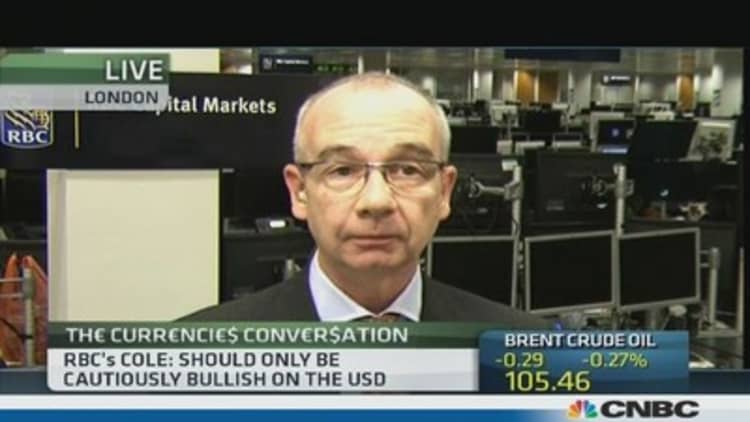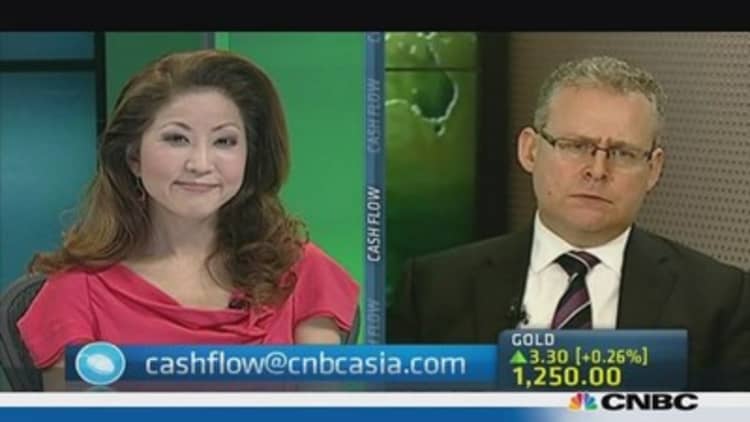The dollar slipped on Wednesday, hurt by gains in sterling and the Australian currency, but the greenback's outlook remained upbeat as the Federal Reserve might be a week away from its next round of reduction in asset buying.
Sterling surged to a three-week high versus the dollar while the Aussie dollar rose to a one-week peak after robust economic numbers that spoke for tighter monetary policy in their economies.
"Sterling and the Aussie dollar are separate issues by themselves, but in terms of the U.S. dollar, the market is still comfortable adding to long positions as the Fed tapering remains on track," said Vassili Serebriakov, currency strategist at BNP Paribas in New York.
Many in the market expect the Fed to slow its monthly bond purchases to a $65 billion pace from $75 billion at its policy meeting next week.
(Read more: Lower inflation target - a mistake for BOJ)
The dollar index, a measure of the dollar's value against six major currencies, was up 0.1 percent on the day at 81.17. The index has been trading in narrow ranges this week.
Wednesday's figures showed that UK unemployment slid to within a whisker of the level at which the Bank of England has said it might consider a rise in interest rates, driving sterling - the best performing major currency the past six months - higher against both the euro and dollar.

Sterling last traded at $1.6578, up 0.6 percent, while the euro fell 0.5 percent to 81.84 pence.
Regardless of another warning by the UK central bank that it is in no hurry to raise rates which have been at rock bottom since 2008, the jobless figures added to a growth picture that is far brighter than most of mainland Europe.
The largest quarterly rise in inflation in over two years, meanwhile, has dampened expectations of further cuts in rates in Australia and helped the Aussie gain almost 1 percent earlier, all but erasing this year's losses.
(Read more: CNBC poll shows dollar bulls not giving up)
Canada's currency fell after the Bank of Canada held interest rates steady, but said it could cut interest rates if the economy worsens. It also said the Canadian dollar remained strong despite depreciating in recent months, adding that a strong currency will continue to pose challenges on competitiveness for Canada's non-commodity exports .
The greenback soared to its highest in more than four years against the Canadian dollar at C$1.1100. It was last at C$1.1075, up 1 percent.

"The BoC emphasized the downside risks to inflation and essentially argued that the U.S. economy should reprice the U.S. dollar higher, while little can be seen yet in terms of the positive impact on Canadian investments and on exports," said Sebastien Galy, currency strategist, at Societe Generale in New York.
"They take a positive spin on inflation and growth over the longer term ...presumably because the Canadian dollar will have weakened so much relative to the U.S. dollar. We continue to target the C$1.15-1.20 region."
Aussie hike
The Aussie had stolen the limelight in early trade, rallying against its U.S. counterpart after an unexpected spike in inflation led investors to cut back bets on another interest rate cut. The was last up 0.5 percent at US$0.8846.
(Read more: UK inflation hits BoE target; first time in 4 years)
The Australian and Canadian dollars are seen weakening in 2014 despite an improving global economy, with their prospects likely to be tied more closely to shifts in monetary policy at home than demand for their commodity exports.
Earlier, the Bank of Japan kicked off the central bank action on Wednesday, holding its policy meeting overnight and retaining its plan for a 60-70 trillion yen annual rise in monetary base. The last traded up 0.1 percent at 104.42 yen.
—By Reuters

